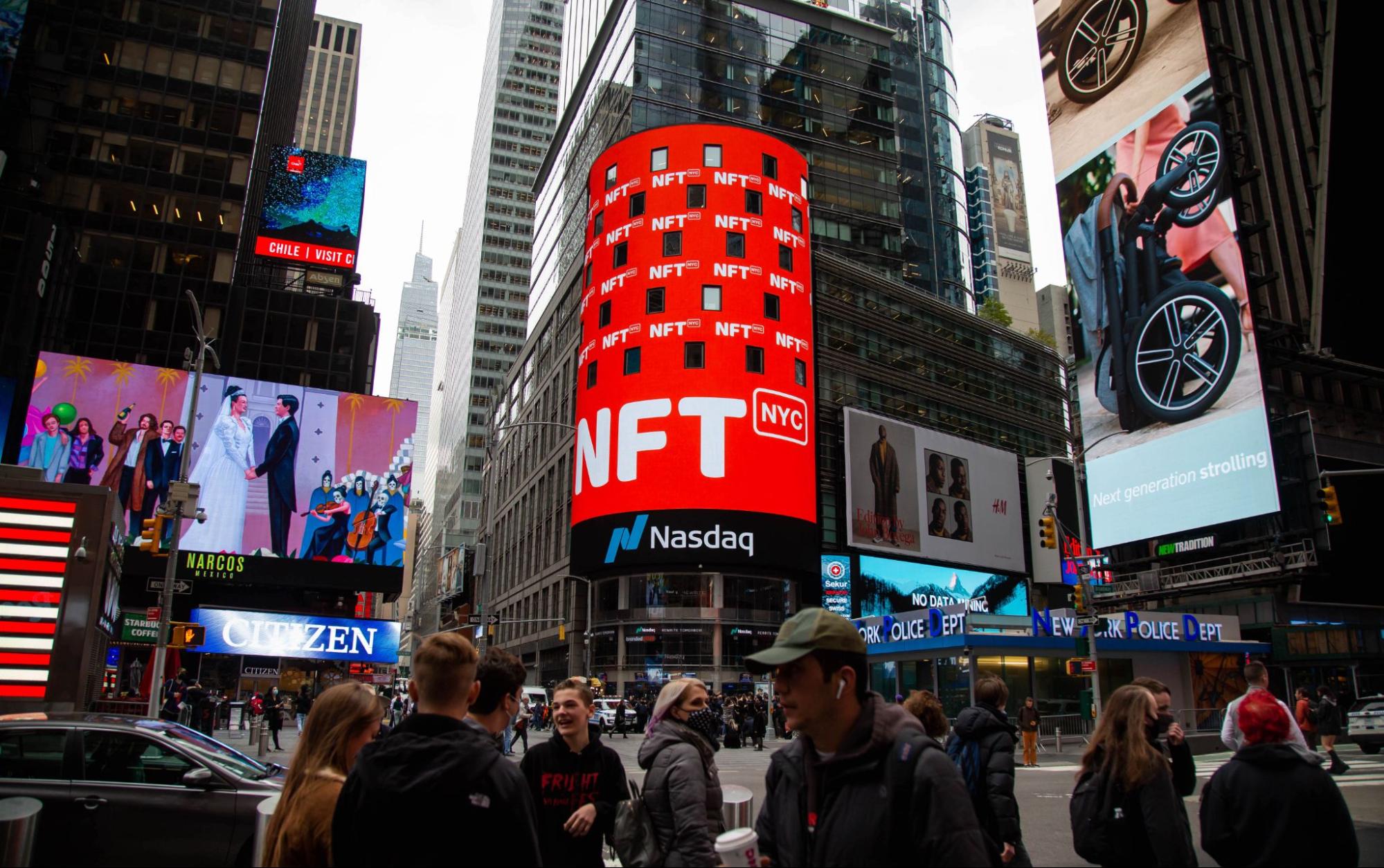Digital real estate is booming

A rare plot of land in Axie Infinity, a Pokémon-meets-crypto game, sold for a record $2.48 million. [Image via Axie Infinity]
There’s never a dull moment on the blockchain. Here’s what you need to know this week:
Crypto markets faltered, then recovered. COVID news is roiling global markets, but crypto has regained ground since Friday’s selloff.
Digital land sales are setting records. Real estate is not cheap in the metaverse.
The week in numbers. The size of Budweiser’s digital beer can collection, and other key figures to know.
Market Report
Bitcoin bounces back after Omicron-variant fears roil markets
In the last week, crypto and stock markets trembled at the emergence of a new COVID variant called Omicron, which prompted a series of international travel bans and fears of new economic lockdowns. Bitcoin dropped nearly 10% over Thanksgiving weekend and the S&P 500 dipped nearly 2.5%. By Monday morning, Bitcoin had regained nearly all of its losses since Friday as reports emerged suggesting the new variant may present mild symptoms compared to other COVID strains, especially for vaccinated people (however, much remains unknown). Meanwhile, international funds, companies, and countries continue to invest in and expand their Bitcoin offerings. Let’s see what’s driving the market.
Global inflation is approaching or has already surpassed multi-decade highs, prompting waves of institutional interest in Bitcoin as a store of value. Last quarter, Morgan Stanley added 2.64 million shares of the Grayscale Bitcoin Trust to its portfolio. MicroStrategy, the publicly traded firm that pioneered corporate crypto investment as an inflation hedge, bought another $414 million in BTC throughout October and November.
Major international funds and financial firms are also incorporating Bitcoin. Multi-trillion dollar investment manager Invesco has launched a product that enables investors to gain exposure to BTC via Germany’s stock market, and investment manager WisdomTree listed three crypto investment products on European exchanges. Meanwhile, Singapore’s Fintonia Group and Australia’s Rest Super fund, which oversees $46.8 billion (AUD), are investing directly in Bitcoin. Rest’s chief investment officer explained: “In an era of inflation, it could be a potentially good place to invest.”
Solutions for commonly cited concerns about regulatory uncertainty and energy use may be on the horizon. This week, a Houston-based firm called Lancium announced that it raised $150 million to build Bitcoin mines powered completely by renewable energy in Texas. And last week, a team of U.S. regulators from the FDIC, the Federal Reserve, and the OCC, announced that they will share detailed guidelines for how banks can use Bitcoin in 2022.
Why it matters… In a Senate hearing yesterday, Fed Chair Jerome Powell noted that “the risk of higher inflation has increased,” and retired the word “transitory” to describe the trend of economic pressure. And as inflation saps the value of fiat currencies (like the Turkish Lira, which has lost more than 45% of its value this year, leading to bread lines and street demonstrations), Bitcoin — which has a max supply of 21 million — has become an increasingly practical hedge for financial institutions, which have more ways than ever to invest in BTC directly and indirectly.
Heavy Meta
How virtual real estate is creating real-world value in the metaverse
Even though Facebook has gone all in on Meta, most of us aren’t exactly living in the metaverse quite yet (unless you count Zoom meetings). But at least one segment of our future digital universe is attracting some pretty tangible valuations — this past week saw record-breaking NFT real estate sales in virtual worlds like Decentraland and crypto games like Axie Infinity. So why are people shelling out for digital properties? And what exactly is the metaverse? Let’s dig in.
A plot of virtual real estate in the 3D world Decentraland just sold for $2.43 million, more than doubling the previous record from June. The buyer, Decrypt reports, was an “NFT-based virtual real estate company” called Metaverse Group, which intends to use the property to "facilitate fashion shows and commerce within the exploding digital fashion industry.”
The NFT game Axie Infinity also set a new record, after “extremely rare” in-game land sold for $2.48 million. The virtual “Genesis” property is highly desirable for its central location on the game’s map and its scarcity — there are only 220 Genesis plots within the game’s 90,601 plots. The trailblazing play-to-earn game, which involves raising and battling Pokémon-like creatures called Axies and earning crypto rewards, was the best-selling NFT collection in the third quarter of 2021, with trade volumes topping $2.5 billion.
But what is the metaverse, exactly? Depends on who you ask. The word “metaverse” comes from sci-fi pioneer Neal Stephenson’s 1992 cyberpunk novel Snow Crash, and most people seem to agree that the metaverse will one day evolve into an all-encompassing, persistent virtual world like the one that Ready Player One imagines. For now, it’s a catchall term for technologies that point in that direction, including everything from people in Venezuela making a living playing Axie Infinity, to virtual fashion shows in Decentraland, to legacy brands like Nike pursuing virtual goods.
Why it matters… The metaverse is already seriously valuable territory — a recent report from crypto-fund giant Grayscale pegged the total market value somewhere north of $1 trillion. And with many of the world’s biggest companies making serious metaverse plays, that number seems likely to grow. It’s also worth noting that — despite the recent buzz — immersive digital universes have existed before. As The Wall Street Journal notes: “Some of what’s been said about the metaverse in the past year could be ripped straight from the late 2000s, when proto-metaverse Second Life enabled, for millions of users, much of what is currently claimed as new.”
Numbers to Know
$3.5 billion
Amount of venture capital raised for crypto projects in November — almost as much as was raised in all of 2020. Coinbase co-founder Fred Ehrsam’s Web3-focused investment firm Paradigm led the way with a record-breaking $2.5 billion crypto fund “to continue investing in the next generation of crypto companies and protocols.”
1 million
Approximate amount of ETH (worth around $4.5 billion) that’s been burned — or removed permanently from circulation — since Ethereum’s EIP-1559 network upgrade went into effect in August. EIP-1559 is intended to make transaction fees more predictable while reducing ETH’s circulating supply, which is now about 118 million coins.
1936
Number of NFTs that make up Budweiser’s first NFT drop. The Budverse Cans Heritage Edition NFTs are based on can designs spanning the company’s history. Each acts as an “entry key to the Budverse,” unlocking special benefits. The collection sold out in under an hour.
26%
Percentage of Japanese crypto holders who also owned NFTs from October 26 to November 1, according to a new survey from Japanese crypto exchange Bitbank. 60% of those NFT owners said they intended to hold the assets long-term.
TOKEN TRIVIA
Bitcoin is to BTC as Polkadot is to:
A
DOT
B
POKE
C
POLKA
D
SPOT
Find the answer below.
Trivia Answer
A
DOT











